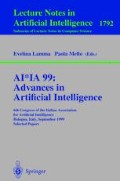Abstract
In this paper we describe a system for perspective-effect removal using the cellular automata paradigm.
The system has been developed as a tool to be included in the vision system of an autonomous robot designed to operate in indoor environments. The navigation of such a robot is guided by traffic signs by means of a neural-network based system. By using such a tool as part of the vision system, it is possible to instruct the neural networks with a training set including only frontal views of the signs, thus simplifying training and making it computationally much lighter. Furthermore, using a low-cost massively parallel architecture implementing the cellular automata paradigm, makes the algorithm much more computationally efficient with respect to sequential implementations, thus making it possible for the robot to perform just-in-time operations.
Access this chapter
Tax calculation will be finalised at checkout
Purchases are for personal use only
Preview
Unable to display preview. Download preview PDF.
References
S. Wolfram, Theory and Applications of Cellular Automata, World Scientific Publ. Co, Singapore, 1986.
R. Y. Tsai, “A versatile camera calibration technique for high-accuracy 3D machine vision metrology using off-the-shelf TV cameras and lenses”, IEEE Journal of Robotics and Automation, vol. 3, no. 4, 1987.
R. M. Haralick, “Monocular vision using inverse perspective projection geometry: Analytic relations”, in Proc. of CVPR, 1989.
N. Margolus, “CAM-8: a computer architecture based on cellular automata”, in Pattern Formation and Lattice-Gas Automata. American Mathematical Society, 1994.
A. Van Dam J. Foley, S. Feiner, and J. Hughes, Computer Graphics: Principles and Practice, Addison-Wesley, Reading, MA, 1995.
M. Bertozzi and A. Broggi, “Vision-based Vehicle Guidance”, IEEE Computer, vol. 30, no. 7, 1997.
G. Adorni, M. Gori, and M. Mordonini, “Just-in-Time Sign Recognition in Image Sequences”, Journal of Real-Time Imaging, no. 5, pp. 95–107, 1999.
Author information
Authors and Affiliations
Editor information
Editors and Affiliations
Rights and permissions
Copyright information
© 2000 Springer-Verlag Berlin Heidelberg
About this paper
Cite this paper
Adorni, G., Cagnoni, S., Mordonini, M. (2000). Cellular Automata based Inverse Perspective Transform as a Tool for Indoor Robot Navigation. In: Lamma, E., Mello, P. (eds) AI*IA 99: Advances in Artificial Intelligence. AI*IA 1999. Lecture Notes in Computer Science(), vol 1792. Springer, Berlin, Heidelberg. https://doi.org/10.1007/3-540-46238-4_30
Download citation
DOI: https://doi.org/10.1007/3-540-46238-4_30
Published:
Publisher Name: Springer, Berlin, Heidelberg
Print ISBN: 978-3-540-67350-7
Online ISBN: 978-3-540-46238-5
eBook Packages: Springer Book Archive

